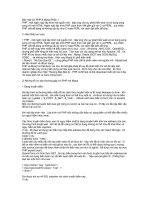Lecture06 synchronization 1
Bạn đang xem bản rút gọn của tài liệu. Xem và tải ngay bản đầy đủ của tài liệu tại đây (796.67 KB, 6 trang )
3/17/2016
Synchronization
IT4371: Distributed Systems
Spring 2016
Until now, we have looked at:
how entities are named and identified
how entities communicate with each other
Synchronization - 1
In addition to the above requirements, entities in DS often
have to cooperate and synchronize to solve the problem
correctly
Dr. Nguyen Binh Minh
Department of Information Systems
School of Information and Communication Technology
Hanoi University of Science and Technology
e.g., In a distributed file system, processes have to synchronize
and cooperate such that two processes are not allowed to write to
the same part of a file
Need for Synchronization – Example 1
Need for Synchronization – Example 2
Vehicle tracking in a City Surveillance System using a Distributed Sensor Network of
Cameras
Writing a file in a Distributed File System
Objective: To keep track of suspicious vehicles
Camera Sensor Nodes are deployed over the city
Each Camera Sensor that detects the vehicle reports the time to a central server
Server tracks the movement of the suspicious vehicle
Client A
1:02
1:08 PM:
Car spotted
Write data1 to file
at offset 0
If the sensor nodes do not
have a consistent version of
the time, the vehicle cannot
be reliably tracked
12:15
1:15 PM:
PM:
Car
Car spotted
spotted
1:17 PM:
12:07
PM:
Car spotted
Server
Distributed
File
abc.txt
1:05 PM:
Car spotted
3:00
1:00 PM:
Car spotted
Client B
Client C
Write data3 to file abc.txt
at offset 1
Write data2 to file abc.txt
at offset 10
If the distributed clients do not synchronize their write operations
to the distributed file, then the data in the file can be corrupted
1
3/17/2016
A Broad Taxonomy of Synchronization
Overview
Today’s lecture
Reason for
synchronization and
cooperation
Entities have to agree on
ordering of events
Entities have to share
common resources
Time Synchronization
Physical Clock Synchronization (or, simply, Clock Synchronization)
Here, actual time on computers are synchronized
e.g., Reading and writing in a
Distributed File System
Examples
e.g., Vehicle tracking in a Camera Sensor
Network, Financial transactions in Distributed
eCommerce Systems
Requirement for
entities
Entities should have a common
understanding of time across different
computers
Entities should coordinate and agree
on when and how to access resources
Topics we will study
Time Synchronization
Mutual Exclusion
Logical Clock Synchronization
Computers are synchronized based on relative ordering of events
Mutual Exclusion
How to coordinate between processes that access the same resource?
Election Algorithms
Here, a group of entities elect one entity as the coordinator for solving a problem
Next two lectures
Overview
Clock Synchronization
Time Synchronization
Clock Synchronization
Logical Clock Synchronization
Clock Synchronization is a mechanism to synchronize the time
of all the computers in a DS
Mutual Exclusion
Election Algorithms
We will study
Coordinated Universal Time
Tracking Time on a Computer
Clock Synchronization Algorithms
Cristian’s Algorithm
Berkeley Algorithm
Network Time Protocol
2
3/17/2016
Clock Synchronization
Coordinated Universal Time
Tracking Time on a Computer
Clock Synchronization Algorithms
Cristian’s Algorithm
Network Time Protocol
Berkeley Algorithm
Coordinated Universal Time (UTC)
All the computers are generally synchronized to a standard time called
Coordinated Universal Time (UTC)
UTC is the primary time standard by which the world regulates clocks and time
UTC is broadcasted via the satellites
UTC broadcasting service provides an accuracy of 0.5 msec
Computer servers and online services with UTC receivers can be
synchronized by satellite broadcasts
Many popular synchronization protocols in distributed systems use UTC as a
reference time to synchronize clocks of computers
Clock Synchronization
Coordinated Universal Time
Tracking Time on a Computer
Clock Synchronization Algorithms
Cristian’s Algorithm
Berkeley Algorithm
Network Time Protocol
Tracking Time on a Computer
How does a computer keep track of its time?
Each computer has a hardware timer
The timer causes an interrupt ‘H’ times a second
The interrupt handler adds 1 to its Software Clock (C)
Issues with clocks on a computer
In practice, the hardware timer is imprecise
It does not interrupt ‘H’ times a second due to material imperfections of the hardware and
temperature variations
The computer counts the time slower or faster than actual time
3
3/17/2016
Clock Skew
Clock Skew (cont’d)
Frequency of the clock is defined as the ratio of the number of seconds counted by the software
clock for every UTC second
When the UTC time is t, let the clock on the computer have a time
C(t)
Frequency = dC/dt
Skew of the clock is defined as the extent to which the frequency differs from that of a perfect
clock
Three types of clocks are possible
Perfect clock:
The timer ticks more than ‘H’ interrupts a second
dC/dt > 1
Slow clock:
The timer ticks less than ‘H’ interrupts a second
dC/dt > 1
15
dC/dt = 1
Hence,
dC/dt > 1
10
7
dC/dt < 1
dC/dt < 1
0
10
UTC, t
0
Skew 0
1
Maximum Drift Rate of a Clock
The manufacturer of the timer specifies the upper and the lower bound
that the clock skew may fluctuate. This value is known as maximum
drift rate (ρ)
1 – ρ <= dC/dt <= 1 + ρ
for a fast clock
for a perfect clock
for a slow clock
Clock time, Cp(t)
dC/dt = 1
Fast clock:
Skew = dC/dt – 1
Clock time, Cp(t)
The timer ticks ‘H’ interrupts a second
dC/dt = 1
dC/dt < 1
UTC, t
Clock Synchronization
Coordinated Universal Time
Tracking Time on a Computer
Clock Synchronization Algorithms
Cristian’s Algorithm
Berkeley Algorithm
Network Time Protocol
4
3/17/2016
Cristian’s Algorithm – Approach
Cristian’s Algorithm
Client Cli sends a request to Time
Server Ser, time stamped its local clock
time T1
S will record the time of receipt T2
according to its local clock
dTreq is network delay for request
transmission
Flaviu Cristian (in 1989) provided an algorithm to synchronize networked
computers with a time server
The basic idea:
Identify a network time server that has an accurate source for time (e.g., the time
server has a UTC receiver)
All the clients contact the network time server for synchronization
Time Server Ser
T2 T3
T1
Client Cli T1
T1, T2, T3
dTreq
dTres
T4
Ser replies to Cli at its local time T3, piggybacking T1 and T2
Cli receives the reply at its local time T4
dTres is the network delay for response transmission
Now Cli has the information T1, T2, T3 and T4
Assuming that the transmission delay from CliSer and SerCli are the same
T2-T1 ≈ T4–T3
However, the network delays incurred while the client contacts the time
server will have outdated the reported time
The algorithm estimates the network delays and compensates for it
Christian’s Algorithm – Synchronizing Client
Time
Cristian’s Algorithm – Discussion
1. Assumption about packet transmission delays
Client C estimates its offset θ relative to Time Server S
θ = T3 + dTres – T4
= T3 + ((T2-T1)+(T4-T3))/2 – T4
= ((T2-T1)+(T3-T4))/2
• Cristian’s algorithm assumes that the round-trip times for messages exchanged over the
network is reasonably short
• The algorithm assumes that the delay for the request and response are equal
T2 T3
S
C
T1
T4
dTreq
dTres
If θ > 0 or θ < 0, then the client time should be incremented or
decremented by θ seconds
• Will the trend of increasing Internet traffic decrease the accuracy of the algorithm?
• Can the algorithm handle delay asymmetry that is prevalent in the Internet?
• Can the clients be mobile entities with intermittent connectivity?
Cristian’s algorithm is intended for synchronizing computers within intranets
Gradual Time Synchronization at the client
• Instead of changing the time drastically by θ seconds, typically the time is gradually
synchronized
2. A probabilistic approach for calculating delays
• There is no tight bound on the maximum drift between clocks of computers
• The software clock is updated at a lesser/greater rate whenever timer interrupts
Note: Setting clock backward (say, if θ < 0)is not allowed in a DS since
decrementing a clock at any computer has adverse effects on several applications
(e.g., make program)
3. Time server failure or faulty server clock
• Faulty clock on the time server leads to inaccurate clocks in the entire DS
• Failure of the time server will render synchronization impossible
5
3/17/2016
Summary
Physical clocks on computers are not accurate
Next Classes
Remaining topics in Time Synchronization
Clock Synchronization
Clock synchronization algorithms provide mechanisms to synchronize
clocks on networked computers in a DS
Computers on a local network use various algorithms for synchronization
Some algorithms (e.g, Cristian’s algorithm) synchronize time with by contacting
centralized time servers
Berkeley algorithm, Network Time Protocol
Logical Clock Synchronization
Computers are synchronized based on relative ordering of events
Mutual Exclusion
How to coordinate between processes that access the same resource?
6









